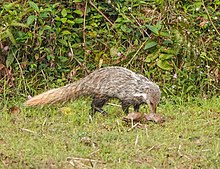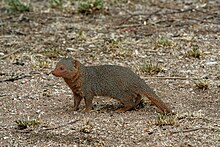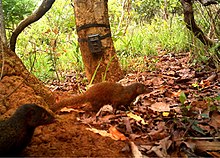Mongooses
Etymology
The name is derived from names used in India for Herpestes species: muṅgūs or maṅgūs in classical Hindi; muṅgūs in Marathi; mungisa in Telugu; mungi, mungisi and munguli in Kannada.
The form of the English name (since 1698) was altered to its "-goose" ending by folk etymology. It was spelled "mungoose" in the 18th and 19th centuries.
The plural form is "mongooses".
Characteristics
Mongooses have long faces and bodies, small, rounded ears, short legs, and long, tapering tails. Most are brindled or grizzly; a few have strongly marked coats which bear a striking resemblance to mustelids. Their nonretractile claws are used primarily for digging. Mongooses, much like goats, have narrow, ovular pupils. Most species have a large anal scent gland, used for territorial marking and signaling reproductive status and a short and smooth penis with a baculum and an elongated urethral opening on its underside. The dental formula of mongooses is 3.1.3–4.1–23.1.3–4.1–2. They range from 24 to 58 cm (9.4 to 22.8 in) in head-to-body length, excluding the tail. In weight, they range from 320 g (11 oz) to 5 kg (11 lb).
Mongooses are one of at least four known mammalian taxa with mutations in the nicotinic acetylcholine receptor that protect against snake venom. Their modified receptors prevent the snake venom α-neurotoxin from binding. These represent four separate, independent mutations. In the mongoose, this change is effected, uniquely, by glycosylation.
Taxonomy
Herpestina was a scientific name proposed by Charles Lucien Bonaparte in 1845 who considered the mongooses a subfamily of the Viverridae. In 1864, John Edward Gray classified the mongooses into three subfamilies: Galidiinae, Herpestinae and Mungotinae. This grouping was supported by Reginald Innes Pocock in 1919, who referred to the family as "Mungotidae".
Genetic research based on nuclear and mitochondrial DNA analyses revealed that the Galidiinae are more closely related to Madagascar carnivores, including the fossa and Malagasy civet. Galidiinae is considered a subfamily of Eupleridae.
| Subfamily | Genus | Species | Image of type species |
|---|---|---|---|
| Herpestinae | Herpestes Illiger, 1811 |
|

|
| Atilax Cuvier, 1826 | Marsh mongoose (A. paludinosus) (Cuvier, 1829) | 
| |
| Cynictis Ogilby, 1833 | Yellow mongoose (C. penicillata) (Cuvier, 1829) | 
| |
| Urva Hodgson, 1836 |
|

| |
| Ichneumia Geoffroy Saint-Hilaire, 1837 | White-tailed mongoose (I. albicauda) (Cuvier, 1829) | 
| |
| Bdeogale Peters, 1850 |
|

| |
| Rhynchogale Thomas, 1894 | Meller's mongoose (R. melleri) Gray, 1865 | 
| |
| Paracynictis Pocock, 1916 | Selous's mongoose (P. selousi) (de Winton, 1896) | 
| |
| Xenogale Allen, 1919 | Long-nosed mongoose (X. naso) (de Winton, 1901) | 
| |
| Mungotinae | Mungos E. Geoffroy Saint-Hilaire & F. Cuvier, 1795 |
|

|
| Suricata Desmarest, 1804 | Meerkat (S. suricatta) (Schreber, 1776) | 
| |
| Crossarchus Cuvier, 1825 |
|

| |
| Helogale Gray, 1861 |
|

| |
| Dologale Thomas, 1920 | Pousargues's mongoose (D. dybowskii) Pousargues, 1894 | 
| |
| Liberiictis Hayman, 1958 | Liberian mongoose (L. kuhni) Hayman, 1958 |
Phylogenetic relationships
Phylogenetic research of 18 mongoose species revealed that the solitary and social mongooses form different clades. The phylogenetic relationships of Herpestidae are shown in the following cladogram:
| Herpestidae |
| ||||||||||||||||||||||||||||||||||||||||||||||||||||||||||||||||||||||||||||||||||||||||||||||||||||||||||||||||||||||||||||||||||||||||||||||||||||||||||||||||||||||||||||||||||||||||||
Extinct species
- †A. mesotes Ewer 1956
- †H. lemanensis Pomel, 1853
Leptoplesictis Major, 1903
- †L. atavus Beaumont, 1973
- †L. aurelianensis Schlosser, 1888
- †L. filholi Gaillard, 1899
- †L. mbitensis Schmidt-Kittler, 1987
- †L. namibiensis Morales et al., 2008
- †L. peignei, Grohé et al., 2020
- †L. rangwai Schmidt-Kittler, 1987
- †L. senutae Morales et al., 2008
Behaviour and ecology
Mongooses mostly feed on insects, crabs, earthworms, lizards, birds, and rodents. However, they also eat eggs and carrion.
Some species can learn simple tricks. They can be tamed and are kept as pets to control vermin.
Cultural significance
In ancient Mesopotamia, mongooses were sacred to the deity Ninkilim, who was conflated with Ningirama, a deity of magic who was invoked for protection against serpents. According to a Babylonian popular saying, when a mouse fled from a mongoose into a serpent's hole, it announced, "I bring you greetings from the snake-charmer!" A creature resembling a mongoose also appears in Old Babylonian glyptic art, but its significance is not known.
All mongoose species, except for Suricata suricatta, are classed as a "prohibited new organism" under New Zealand's Hazardous Substances and New Organisms Act 1996, preventing them from being imported into the country.
This section needs additional citations for verification. (October 2020) |
A well-known fictional mongoose is Rikki-Tikki-Tavi, who appears in a short story of the same title in The Jungle Book (1894) by Rudyard Kipling. In this tale set in India, a young pet mongoose saves his human family from a krait and from Nag and Nagaina, two cobras. The story was later made into several films and a song by Donovan, among other references. A mongoose is also featured in Bram Stoker's novel The Lair of the White Worm. The main character, Adam Salton, purchases one to independently hunt snakes. Another mongoose features in the denouement of the Sherlock Holmes story "The Adventure of the Crooked Man", by Sir Arthur Conan Doyle. The Indian Tamil devotional film Padai Veetu Amman shows Tamil actor Vinu Chakravarthy changing himself into a mongoose by using his evil tantric mantra, to fight the goddess Amman. However, the mongoose finally dies at the hands of the goddess.
Mongoose species are prohibited to be kept as pets in the United States.
See also
References
- ^ Wozencraft, W. C. (2005). "Family Herpestidae". In Wilson, D. E.; Reeder, D. M. (eds.). Mammal Species of the World: A Taxonomic and Geographic Reference (3rd ed.). Johns Hopkins University Press. pp. 562–571. ISBN 978-0-8018-8221-0. OCLC 62265494.
- ^ Gilchrist, J.S.; Jennings, A.P.; Veron, G. & Cavallini, P. (2009). "Family Herpestidae (Mongooses)". In Wilson, D. E. & Mittermeier, R. A. (eds.). Handbook of the Mammals of the World. Vol. 1. Carnivores. Barcelona: Lynx Edicions. pp. 262–328. ISBN 978-84-96553-49-1.
- ^ Patou, M.; Mclenachan, P.A.; Morley, C.G.; Couloux, A.; Jennings, A.P.; Veron, G. (2009). "Molecular phylogeny of the Herpestidae (Mammalia, Carnivora) with a special emphasis on the Asian Herpestes". Molecular Phylogenetics and Evolution. 53 (1): 69–80. Bibcode:2009MolPE..53...69P. doi:10.1016/j.ympev.2009.05.038. PMID 19520178.
- ^ Valentini, M.B. & Major, J.D. (1714). "Viverra Indica grysea. Mungos". Museum museorum, oder, Vollständige Schau Bühne aller Materialien und Specereyen. Vol. 2 Appendix IX. Franckfurt am Mayn: Johann David Zunners Sel. Erben, und Johann Adam Jungen. p. 24.
- ^ Jerdon, T.C. (1874). "127. Herpestes griseus". The mammals of India; a natural history of all the animals known to inhabit continental India. London: J. Wheldon. pp. 132–134.
- ^ Sterndale, R.A. (1884). "Herpestidae. The Ichneumon or Mungoose Family". Natural history of the Mammalia of India and Ceylon. Calcutta: Thacker & Spink. pp. 222–228.
- ^ Lydekker, R. (1894). "XIII. The Mungooses. Genus Herpestes". A hand-book to the Carnivora. Part 1: Cats, civets, and mungooses. London: Edward Lloyd Limited. pp. 244–269.
- ^ Platts, J.T. (1884). "منگوس मुंगूस muṅgūs, or मंगूस maṅgūs. The Mongoose, or ichneumon, Viverra ichneumon". A dictionary of Urdu, classical Hindi, and English. London: W. H. Allen & Co. p. 1081.
- ^ Molesworth, J. T. (1857). "मुंगूस muṅgūsa, Bengal Mungoose, Viverra Ichneumon, or Herpesteus Griseus". A dictionary, Marathi and English (Second, revised and enlarged ed.). Bombay: Printed for Government at the Bombay Education Society's Press. p. 384. Archived from the original on 30 January 2021. Retrieved 5 April 2020.
- ^ Brown, C.P. (1903). "ముంగి or ముంగిస mungi. The ichneumon or mongoose, a kind of weasel. Viverra ichneumon". A Telugu-English dictionary (New, thoroughly revised and brought up to date second ed.). Madras: Promoting Christian Knowledge. p. 997.
- ^ Reeve, W. & Sanderson, D. (1858). "ಮುಂಗಿ, ಮುಂಗಿಸಿ, ಮುಂಗುಲಿ". A dictionary, Canarese and English (Revised, corrected and enlarged ed.). Bangalore: Wesleyan Mission Press. p. 787.
- ^ Forsyth, M. (2012). "Folk etymology". The Etymologicon: A Circular Stroll Through the Hidden Connections of the English Language. Penguin Books. p. 77. ISBN 978-1-101-61176-0.
- ^ Hinton, H. E. & Dunn, A. M. S. (1967). "Preface". Mongooses: Their Natural History and Behaviour. Berkeley: University of California Press. p. v. OCLC 1975837.
- ^ Macdonald, D., ed. (2009). The Encyclopedia of Mammals. Oxford: Oxford University Press. p. 660. ISBN 978-0-19-956799-7.
- ^ Estes, Richard (1991). The Behavior Guide to African Mammals: Including Hoofed Mammals, Carnivores, Primates. University of California Press. ISBN 978-0-520-08085-0.
- ^ Barchan, D.; Kachalsky, S., Neumann, D., Vogel, Z., Ovadia, M., Kochva, E. and Fuchs, S. (1992). "How the mongoose can fight the snake: the binding site of the mongoose acetylcholine receptor" (PDF). Proceedings of the National Academy of Sciences. 89 (16): 7717–7721. Bibcode:1992PNAS...89.7717B. doi:10.1073/pnas.89.16.7717. PMC 49782. PMID 1380164.
{{cite journal}}: CS1 maint: multiple names: authors list (link) - ^ Drabeck, D. H.; Dean, A. M.; Jansa, S. A. (2015). "Why the honey badger don't care: Convergent evolution of venom-targeted nicotinic acetylcholine receptors in mammals that survive venomous snake bites". Toxicon. 99: 68–72. Bibcode:2015Txcn...99...68D. doi:10.1016/j.toxicon.2015.03.007. PMID 25796346.
- ^ Bonaparte, C. L. (1845). "Fam. VII. Viverridae". Catalogo Methodico dei Mammiferi Europei. Milan, Italy: L. di Giacomo Pirola. p. 8.
- ^ Gray, J.E. (1865). "A revision of the genera and species of viverrine animals (Viverridae) founded on the collection in the British Museum". Proceedings of the Zoological Society of London: 502–579.
- ^ Pocock, R. I. (1919). "The classification of mongooses (Mungotidae)". The Annals and Magazine of Natural History. 9 (3): 515–524. doi:10.1080/00222931908673851.
- ^ Yoder, A. D.; Burns, M. M.; Zehr, S.; Delefosse, T.; Veron, G.; Goodman, S. M.; Flynn, J. J. (2003). "Single origin of Malagasy carnivora from an African ancestor". Nature. 421 (6924): 434–437. Bibcode:2003Natur.421..734Y. doi:10.1038/nature01303. PMID 12610623. S2CID 4404379.
- ^ Flynn, J. J.; Finarelli, J.; Zehr, S.; Hsu, J.; Nedbal, M. (2005). "Molecular phylogeny of the Carnivora (Mammalia): Assessing the Impact of Increased sampling on resolving enigmatic relationships". Systematic Biology. 54 (2): 317–337. doi:10.1080/10635150590923326. PMID 16012099.
- ^ Wilson, D. E.; Reeder, D. M., eds. (2005). Mammal Species of the World: A Taxonomic and Geographic Reference (3rd ed.). Johns Hopkins University Press. ISBN 978-0-8018-8221-0. OCLC 62265494.
- ^ Illiger, C. (1815). "Überblick der Säugethiere nach ihrer Verteilung über die Welttheile". Abhandlungen der Königlichen Preußischen Akademie der Wissenschaften zu Berlin. 1804−1811: 39−159. Archived from the original on 4 April 2019. Retrieved 28 December 2019.
- ^ Linnaeus, C. (1758). "Viverra ichneumon". Caroli Linnæi Systema naturæ per regna tria naturæ, secundum classes, ordines, genera, species, cum characteribus, differentiis, synonymis, locis. Vol. Tomus I (Decima, reformata ed.). Holmiae: Laurentius Salvius. p. 41. (in Latin)
- ^ Rüppell, E. (1835). "Herpestes sanguineus. Rüppell". Neue Wirbelthiere zu der Fauna von Abyssinien gehörig. Frankfurt am Main: S. Schmerber. pp. 27–28.
- ^ Wagner, J.A. (1839). "Über die Verwandtschafts-Verhältnisse der Pharaonsratte". Gelehrte Anzeigen der Königlich Bayerischen Akademie der Wissenschaften zu München. 9 (183): 425–429.
- ^ Gray, J.E. (1848). "Description of a new species of Herpestes, from Abyssinia". Proceedings of the Zoological Society of London (November): 138–139.
- ^ Bocage, J.V.B. (1889). "Mammifère d'Angola et du Congo". Jornal de Sciencias Mathematicas, Physicas e Naturaes. 2. 1: 174–185.
- ^ Cuvier, F. G. (1826). "Vansire". In E. Geoffroy Saint-Hilaire; Cuvier, F. G. (eds.). Histoire Naturelle des Mammifères: avec des figures originales, coloriées, dessinées d'aprèsdes animaux vivans. Tome 5. Paris: A. Belin. p. LIV.
- ^ Cuvier, G. (1829). "Les Mangoustes. Cuv. (Herpestes, Illiger)". Le règne animal distribué d'après son organisation, pour servir de base à l'histoire naturelle des animaux et d'introduction à l'anatomie comparée. Paris: Chez Déterville. pp. 157–158.
- ^ Ogilby, W. (1833). "Characters of a new Genus of carnivorous Mammalia from the collection of Mr. Steedman". Proceedings of the Zoological Society of London (Part 1): 48–49.
- ^ Hodgson, B. H. (1836). "Synoptical description of sundry new animals, enumerated in the Catalogue of Nepalese Mammals". Journal of the Asiatic Society of Bengal. 5: 231–238.
- ^ Geoffroy Saint-Hilaire, É. (1817). "De l'Ichneumon. Ichneumon pharaon". In Jomard, E. F. (ed.). Description de l'Égypte, ou, Recueil des observations et des recherches qui ont été faites en Égypte pendant l'éxpédition de l'armée française. Vol. Tome II. Paris: Commission des Sciences et Arts d'Egypte. pp. 137–144.
- ^ Bennett, E. T. (1835). "Remarks on some Mammalia from Travancore, including a New Species of Herpestes". Proceedings of the Zoological Society of London. III: 66–67.
- ^ Gray, J. E. (1837). "Description of some or little known Mammalia, principally in the British Museum Collection". The Magazine of Natural History and Journal of Zoology, Botany, Mineralogy, Geology and Meteorology. I (November): 577–587.
- ^ Waterhouse, G. R. (1838). "On two new species of Mammalia, from the Society's collection, belonging to the genera Gerbillus and Herpestes". Proceedings of the Zoological Society of London. VI: 55–56.
- ^ Gray, J.E. (1846). "New species of Mammalia". The Annals and Magazine of Natural History; Zoology, Botany, and Geology. 18 (118): 211–212.
- ^ Geoffroy Saint-Hilaire, I. (1837). "Notices sur deux nouveaux genres de Mammifères carnassiers, les Ichneumies, du continent Africain, et les Galidies de Madagascar". Annales des Sciences Naturelles. 2. 8: 249–252.
- ^ Peters, W. (1850). "Bdeogale". Sitzungsberichte der Gesellschaft Naturforschender Freunde zu Berlin: 94.
- ^ Peters, W. (1852). "Mittheilung über die in Mossambique beobachteten Mangusten". Verhandlungen der Königlich Preussischen Akademie der Wissenschaften zu Berlin: 81–82.
- ^ Pucheran, J.P. (1855). "Les Mammifères de la côte occidental d'Afrique". Revue et magasin de zoologie pure et appliquée. 2. 7: 111.
- ^ Thomas, O. (1894). "On a new African Genus of Mustelidae". The Annals and Magazine of Natural History; Zoology, Botany, and Geology. 6. 13 (78): 522–524.
- ^ Heller, E. (1914). "New antelopes and carnivores from British East Africa". Smithsonian Miscellaneous Collections. 61 (2240): 1–15.
- ^ Foley, C. & Do Linh San, E. (2016). "Bdeogale omnivora". IUCN Red List of Threatened Species. 2016: e.T136686A45221619.
- ^ Thomas, O. (1894). "On the mammals of Nyasaland: third contribution". Proceedings of the Zoological Society of London (February): 136–146.
- ^ Allen, J. A. (1919). "Preliminary notes on African Carnivora". Journal of Mammalogy. 1 (1): 23–31. doi:10.2307/1373716. JSTOR 1373716.
- ^ de Winton, W. E. (1901). "Description of a New Mongoose from West Africa". Bulletin of the Liverpool Museums Under the City Council. 3 (2): 35–37.
- ^ Geoffroy, E. & Cuvier, F. (1795). "Mémoire sur une nouvelle division des Mammifères, et sur Ies principes qui doivent servir de base dans cette sorte de travail, lu à la société d'Histoire naturelle, le premier floréal de l'an troisième". In Millin; Noel & Warens (eds.). Magasin Encyclopédique: ou journal des sciences, des lettres et des arts. Vol. Tome second. Paris: I'lmprimerie du Magazin Encyclopédique. pp. 164–189.
- ^ Gmelin, J. F. (1788). "Viverra mungo". Caroli a Linné, Systema naturae per regna tria naturae, secundum classes, ordines, genera, species, cum characteribus, differentiis, synonymis, locis. Vol. I (13th aucta, reformata ed.). Lipsiae: Georg Emanuel Beer. pp. 84–85.
- ^ Ogilby, W. (1835). "Descriptions of Mammalia and Birds from the Gambia". Proceedings of the Zoological Society of London. Part III: 97–105.
- ^ Desmarest, A. G. (1804). "Genre Surikate, Suricata Nob.". In Deterville, J. F. P. (ed.). Nouveau dictionnaire d'histoire naturelle appliquée aux arts: principalement à l'agriculture et à l'économie rurale et domestique. Vol. 24. Paris: Deterville. p. 15.
- ^ Schreber, J. C. D. (1776). "Viverra suricata". Die Säugethiere in Abbildungen nach der Natur, mit Beschreibungen. Erlangen: Expedition des Schreber'schen Säugthier- und des Esper'schen Schmetterlingswerkes. p. CVII.
- ^ de Pousargues, E. (1894). "Description d'une nouvelle espèce de mammifère du genre Crossarchus et considérations sur la répartition géographique des crossarques rayés". Nouvelles Archives du Muséum d'Histoire Naturelle. 3 (in French). 6: 121–134.
- ^ Veron, G.; Colyn, M.; Dunham, A.E.; Taylor, P.; Gaubert, P. (2004). "Molecular systematics and origin of sociality in mongooses (Herpestidae, Carnivora)". Molecular Phylogenetics and Evolution. 30 (3): 582–598. Bibcode:2004MolPE..30..582V. doi:10.1016/S1055-7903(03)00229-X. PMID 15012940.
- ^ Barycka, E. (2005). "Evolution and systematics of the feliform Carnivora". Mammalian Biology. 72 (5): 257–282. doi:10.1016/j.mambio.2006.10.011.
- ^ Morales, J.; Pickford, M.; Salesa, M.J. (2008). "Creodonta and Carnivora from the Early Miocene of the Northern Sperrgebiet, Namibia". Memoir of the Geological Survey of Namibia. 20: 291–310.
- ^ Cronk, N. E.; Pillay, N. (2018). "Food choice and feeding on carrion in two African mongoose species in an urban environment". Acta Ethologica. 21 (2): 127–136. doi:10.1007/s10211-018-0291-x. S2CID 21688548.
- ^ Sherman, D. M. (2007). Tending Animals in the Global Village: A Guide to International Veterinary Medicine. John Wiley & Sons. ISBN 978-0-470-29210-5.
- ^ Black, J.; Green, A. (1992). Gods, Demons and Symbols of Ancient Mesopotamia: An Illustrated Dictionary. The British Museum Press. p. 132. ISBN 0-7141-1705-6.
- ^ "Hazardous Substances and New Organisms Act 2003 - Schedule 2 Prohibited new organisms". New Zealand Government. Retrieved 26 January 2012.
- ^ Krueger, A. (2010). "Remembering Duluth's famous mongoose, Mr. Magoo". Duluth News Tribune. Archived from the original on 1 February 2014.
Further reading
- Rasa, A. (1986). Mongoose Watch: A Family Observed. Garden City, N.Y.: Anchor Press, Doubleday & Co. ISBN 978-0-385-23175-6. OCLC 12664019.
- Lodrick, D. O. (1982). "Man and Mongoose in Indian Culture". Anthropos. 77 (1/2): 191–214. JSTOR 40460438.
External links
- . Encyclopædia Britannica (11th ed.). 1911.